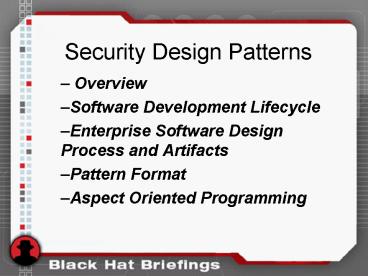Security Design Patterns - PowerPoint PPT Presentation
1 / 36
Title:
Security Design Patterns
Description:
... way to capture requirements using actors and actions to show structure ... 'If I wanted you to understand I would have explained it better,' Johan Cruyff ... – PowerPoint PPT presentation
Number of Views:99
Avg rating:3.0/5.0
Title: Security Design Patterns
1
Security Design Patterns
- Overview
- Software Development Lifecycle
- Enterprise Software Design Process and Artifacts
- Pattern Format
- Aspect Oriented Programming
2
Security Design Patterns
- Focus of this presentation
- Architecture-centric (AOP)
- Enterprise Focus
- Technology Agnostic
- Collaboration between Security, Business, and
Development
3
Development Lifecycle
- Software Development Lifecycle
- Analysis focuses on requirements gathering and
high level definitions - Design drills down on technical issues,
distributions, and refines requirements - Construction building and testing the system
- Transition "going live!"
4
SW Security Architect Role
- Provides Leadership
- Facilitate Collaboration between disparate
stakeholders - Focus on Design Process
Architect
Business
Security
Dev
Data
Ops
5
Analysis Phase
- "A problem, properly stated, is a problem on its
way to being solved," Buckminster Fuller - Concerned with the what not the how
- What is the business value of security?
- Artifacts
- Functional non-functional requirements
- Security requirements are often negative
- Use Cases
6
Use Case
- A specific way to capture requirements using
actors and actions to show structure and
relationships - Defines both text document and diagram formats
- Use Cases drive the development process
7
Use Case
- Use Case Example user transferring money on bank
website system
8
Use Case
- Use Case Attributes
- Goal/Context
- Boundaries
- Preconditions
- End Condition Success/Fail
- Actor/Roles
- Actions
9
Mis-Use Cases
- Look at the system from an attacker point of view
- Useful to glean security requirements
- Discussed in paper by Guttorm Sindre and Andreas
Opdahl. - More information at www.ifi.uib.no/conf/refsq2001
/papers/p25.pdf
10
Mis-Use Case Example
- Attacker View of Bank Website
11
Mis-Use Case Benefit
- Defending Against Login Subversion
12
Design Phase
- Goals of this phase include
- System, object, component design
- Prototyping
- Design Artifacts
- CRC Cards Class, Responsibility, Collaboration
- Class Sequence Diagrams
- Common ServicesLogging/Security/Exception
13
Threat Modeling
- Elaborates on threats in MisUse case analysis
- Focus on distilling
- Threat impact level
- Threat likelihood
- Mitigation, management, and containment
14
Design Patterns
- Christopher Alexander
- Timeless Way of Building Pattern Language
- Pattern definition
- "Each pattern describes a problem which occurs
over and over again in our environment, and then
describes the core of the solution to that
problem, in such a way that you can use this
solution a million times over, without ever doing
it the same way twice," Alexander
15
Design Patterns
- Gang of Four Design Patterns
- Defined three pattern types
- Creational
- Structural
- Behavioral
- Basic Pattern Template
- Problem, Context, Solution
16
Security Design Patterns
- Derived from Solutions to Mis-Use Cases and
Threat models - Encompass prevention, detection, and response
(Schneier, Secrets and Lies) - Context and pattern relationships equally
important as individual problems and solutions
17
Input Validator Pattern
- Context distributed applications are typically
built to be client independent. - Problem a minimum of assumptions and control of
client interface creates possibility of malicious
input. Malicious input can be used to gain
unauthorized access to system processes and
resources
18
Input Validator Pattern
- Solution Do not trust input. Validate input
against acceptable value criteria.
19
Improving The Solution with AOP
- Aspect Oriented Programming Basics
- AOP and OOP collaborate
- Ability to address cross cutting concerns (like
security!) in a modular way - Component Relationships
- Tool Support AspectJ, HyperJ (IBM), AspectWerks,
Nanning (see www.aosd.net) - Not Just Java
20
AOP Concepts
- AspectJ Basics
- Aspect
- Join Point
- Location
- Pointcut
- Context gathering/assembling
- Advice
- Introduction
21
Refactoring with AspectJ
- Login Use Case
22
Refactoring with AspectJ
- Additional Use Cases
23
Refactoring with AspectJ
- Classes with Getters
24
Refactoring with AspectJ
- AspectJ modularizes common behavior
- before() call(void Facade.get(..))
call(void Facade.update(..))
InputValidator.validate()
25
Exception Manager Pattern
- If I wanted you to understand I would have
explained it better, Johan Cruyff - Context differentiate between exception handling
and exception management - Java exception handling paradigm
- Problem exceptions can write sensitive data,
i.e. Database connection info, to logs or to user
screen.
26
Exception Manager Pattern
- Solution Use structured exception handling, wrap
exceptions, and sanitize exception information
for display
27
Secure Logger Pattern
- Contextbalance between performance and
analytical purposes - Problem
- Distributed Systems
- Centralize vs. decentralize
- Time
- Management
28
Secure Logger Pattern
- Solution remote logging host
29
Secure Logger Pattern
- Solution deployment diagram
30
Secure Logger Pattern
- Logging in Java
31
Secure Logger Pattern
- SloggerAspect.java
- before() call(void Facade.get(..))
call(void Facade.update(..)) //assemble
context init logger methods - after() call(void Facade.get(..))
call(void Facade.update(..)) //final logger
methods
32
Patterns
- Modular Behavior
33
Construction Phase
- Concerned with building, integrating, and testing
code - Iterate
- Use unit tests like Junit (www.junit.org) and
Nunit to validate your design assumptions
34
Build and Unit Test Process
- Separation of privileges
- Developer Level
- Compile
- Unit test
- Integration Level
- Build
- Configure
- Deploy
- Promote
35
Transition Phase
- "There's nothing like bringing in a herd," City
Slickers - Moving to operational mode
- Where security usually begins
- Operational plans, monitoring processes
Incident response
36
Questions?
- More information and free, monthly architecture
newsletter at www.arctecgroup.net/articles.htm































